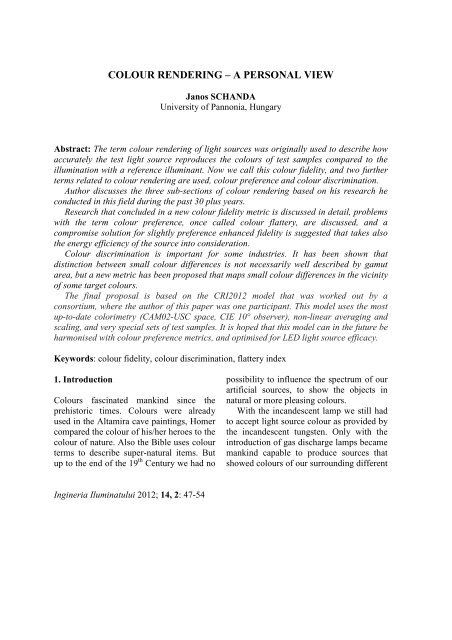Untitled - Journal of Lighting Engineering
Untitled - Journal of Lighting Engineering
Untitled - Journal of Lighting Engineering
Create successful ePaper yourself
Turn your PDF publications into a flip-book with our unique Google optimized e-Paper software.
COLOUR RENDERING – A PERSONAL VIEW<br />
Ingineria Iluminatului 2012; 14, 2: 47-54<br />
Janos SCHANDA<br />
University <strong>of</strong> Pannonia, Hungary<br />
Abstract: The term colour rendering <strong>of</strong> light sources was originally used to describe how<br />
accurately the test light source reproduces the colours <strong>of</strong> test samples compared to the<br />
illumination with a reference illuminant. Now we call this colour fidelity, and two further<br />
terms related to colour rendering are used, colour preference and colour discrimination.<br />
Author discusses the three sub-sections <strong>of</strong> colour rendering based on his research he<br />
conducted in this field during the past 30 plus years.<br />
Research that concluded in a new colour fidelity metric is discussed in detail, problems<br />
with the term colour preference, once called colour flattery, are discussed, and a<br />
compromise solution for slightly preference enhanced fidelity is suggested that takes also<br />
the energy efficiency <strong>of</strong> the source into consideration.<br />
Colour discrimination is important for some industries. It has been shown that<br />
distinction between small colour differences is not necessarily well described by gamut<br />
area, but a new metric has been proposed that maps small colour differences in the vicinity<br />
<strong>of</strong> some target colours.<br />
The final proposal is based on the CRI2012 model that was worked out by a<br />
consortium, where the author <strong>of</strong> this paper was one participant. This model uses the most<br />
up-to-date colorimetry (CAM02-USC space, CIE 10° observer), non-linear averaging and<br />
scaling, and very special sets <strong>of</strong> test samples. It is hoped that this model can in the future be<br />
harmonised with colour preference metrics, and optimised for LED light source efficacy.<br />
Keywords: colour fidelity, colour discrimination, flattery index<br />
1. Introduction<br />
Colours fascinated mankind since the<br />
prehistoric times. Colours were already<br />
used in the Altamira cave paintings, Homer<br />
compared the colour <strong>of</strong> his/her heroes to the<br />
colour <strong>of</strong> nature. Also the Bible uses colour<br />
terms to describe super-natural items. But<br />
up to the end <strong>of</strong> the 19 th Century we had no<br />
possibility to influence the spectrum <strong>of</strong> our<br />
artificial sources, to show the objects in<br />
natural or more pleasing colours.<br />
With the incandescent lamp we still had<br />
to accept light source colour as provided by<br />
the incandescent tungsten. Only with the<br />
introduction <strong>of</strong> gas discharge lamps became<br />
mankind capable to produce sources that<br />
showed colours <strong>of</strong> our surrounding different
















